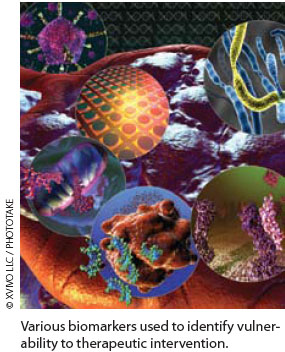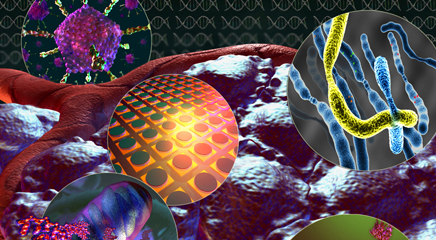Personalized medicine—delivery of targeted therapies tailored to individual patients using genetic or other biomarker assays to determine treatment regimens—is importantly advancing clinical oncology. Pharmacogenomic treatment planning uses patient and tumor genetic markers to identify which patients are likely to benefit from a particular chemotherapy. Perhaps most famously, patients with HER2/NEU-positive breast tumors frequently benefit from trastuzumab (Herceptin) therapy, whereas HER2/NEU-negative tumors do not respond to this treatment.
Recent advances allow closer conformation of radiation fields to tumor contours and reduced irradiation of healthy nontarget tissues; however, radiation toxicity remains a common source of morbidity in cancer patients, limiting delivery of potentially curative radiation doses. Patient radiosensitivities and radiation toxicities vary markedly, even among patients receiving identical radiotherapeutic regimens.1 If biomarkers predictive of radiation toxicity are identified, radiotherapy can enter the personalized medicine revolution, allowing more aggressive treatments for less radiosensitive patients and identifying those highly radiosensitive patients for whom more conservative treatment plans should be devised, thereby improving cure rates while reducing morbidity.
Catherine West, PhD, Professor of Radiation Biology at the University of Manchester School of Medicine in England, described such predictors of patients’ intrinsic sensitivities to radiation as “the Holy Grail of radiobiology” in the mid 1990s, and helped pioneer the search for that grail, a field now known as radiogenomics.2
 Radiogenomics researchers have focused largely on identifying radiation toxicity-associated genetic markers called single-nucleotide polymorphisms (SNPs).1 “If we know which SNPs confer sensitivity or resistance, we can tailor or personalize radiation treatment,” radiation oncologist Barry S. Rosenstein, MD, another radiogenomics pioneer and a professor of radiation oncology and preventive medicine at Mount Sinai School of Medicine in New York, told Oncology Nurse Advisor. “We used to ascribe adverse effects to a patient’s ‘bad luck’ and treat (with radiation doses) up to tolerance. In recent years, we’ve come to appreciate that genetics probably plays a role. Patients come into the clinic with an inherited risk of adverse responses to radiation.”
Radiogenomics researchers have focused largely on identifying radiation toxicity-associated genetic markers called single-nucleotide polymorphisms (SNPs).1 “If we know which SNPs confer sensitivity or resistance, we can tailor or personalize radiation treatment,” radiation oncologist Barry S. Rosenstein, MD, another radiogenomics pioneer and a professor of radiation oncology and preventive medicine at Mount Sinai School of Medicine in New York, told Oncology Nurse Advisor. “We used to ascribe adverse effects to a patient’s ‘bad luck’ and treat (with radiation doses) up to tolerance. In recent years, we’ve come to appreciate that genetics probably plays a role. Patients come into the clinic with an inherited risk of adverse responses to radiation.”
Early radiogenomic research efforts focused on specific candidate genes believed to be involved in DNA damage repair or other processes associated with biologic responses to irradiation. One of many promising SNPs identified this way was the TGFß1 gene, believed to affect secretion of transforming growth factor ß1 (TGFß1), a cytokine protein implicated in apoptosis (programmed cell death) and fibrosis.2 Several preliminary studies suggested significant associations between one version of the TGFß1 gene (referred to as the –509 TT or simply TT genotype) and late fibrosis risk among patients receiving postmastectomy radiation and rectal bleeding after prostate cancer radiotherapy.2
Subsequent validation efforts failed to confirm the early promise of the TT genotype as a radiosensitivity biomarker. In 2009 and 2010, radiobiologist and oncologist Christian Nicolaj Andreassen, MD, PhD, of Aarhus University Hospital in Denmark, conducted analyses of data from more than a dozen published studies of TGFß1. Andreassen found that stronger findings came from studies with fewer participants, with larger studies’ results clustering around the line of no effect, raising strong suspicions that positive findings had been statistical mirages.2 Despite the biological plausibility of candidate radiosensitivity SNPs, small single-institution studies were “hampered by inconsistent results and a lack of ability to replicate previous association,” Andreassen cautioned.2
Researchers were realizing that small studies by local research teams were yielding statistically unreliable false positives. In 2009, Rosenstein and West joined colleagues in Europe and the United States and established the international Radiogenomics Consortium to share biologic samples and patient data, pooling their data to perform statistically powerful analyses to confirm suspected genetic associations with radiosensitivity.3
In January 2012, West and coauthors reported disappointing news. No previously reported, biologically plausible SNP associations with patient radiosensitivity could be confirmed in a large validation study of 1,613 radiotherapy patients.4
